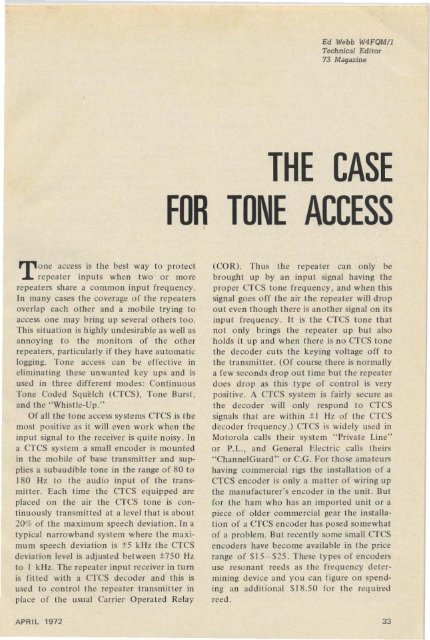Fig - Free and Open Source Software
Fig - Free and Open Source Software
Fig - Free and Open Source Software
Create successful ePaper yourself
Turn your PDF publications into a flip-book with our unique Google optimized e-Paper software.
T o<br />
ne access is the best way to protect<br />
repealer inpu ts when two or more<br />
repeat ers share a common in pu t frequency.<br />
In ma ny cases the coverage of the repeaters<br />
overlap each o the r <strong>and</strong> a mobile trying to<br />
access o ne may bring up several others to o.<br />
This situatio n is highly undesirable as well as<br />
annoying to the monitors o f the other<br />
repeaters, particularly if they have auto ma tic<br />
loggin g. Tone access can he effective in<br />
eliminating these unwanted key ups <strong>and</strong> is<br />
used in three different modes: Co ntinuous<br />
Tone Coded Squelch (CTCS), Tone Burst ,<br />
<strong>and</strong> the " Whistle-Up."<br />
Of all the tone access systems CTCS is the<br />
most positive as it wil l even work when the<br />
input signa l to the receiver is quite noisy . In<br />
a CTCS system a small encoder is mounted<br />
in the mobile of base transmitter <strong>and</strong> su pplies<br />
a subuudible tone in the range of 80 to<br />
180 Hz to the audio input o f the transmitter.<br />
Eac h time the c res equipped are<br />
placed o n the air the c rcs tone is continuously<br />
transmitted at a level that is about<br />
'20% of the maximum speec h deviation. In a<br />
typical narro wb<strong>and</strong> system whe re the ma ximum<br />
speech deviation is +5 k Hz the CTCS<br />
deviation level is adjusted be t ween +750 Hz<br />
to I kHz. T he re peater input receiver in tu m<br />
is fitted wit h a CTCS decoder <strong>and</strong> this is<br />
used to control the repeater transmitter in<br />
place of th e usual Carrier O perated Relay<br />
A PRI L 1972<br />
,<br />
Ed Webb W4FQMIl<br />
Technical Editor<br />
73 Magazine<br />
(CO R), Thus the repeater ca n only be<br />
brought up by an input signal having the<br />
proper c rcs tone frequency. <strong>and</strong> when this<br />
signal goes off the air the repeater will drop<br />
out eve n tho ugh there is another signal o n its<br />
inp ut freq uency . It is the CTCS tone that<br />
not o nly brings the repeater up but also<br />
holds it up <strong>and</strong> when there is no CTCS tone<br />
the decoder cuts the keying voltage o ff to<br />
the transmitter. (Of course there is no rmally<br />
a few seconds d rop o u t time but the repeater<br />
does drop as this type of control is very<br />
positive. A CTCS system is fairly secu re as<br />
the d eco der will o nly respond to LICS<br />
signals that are with in + I liz o f t he LIes<br />
de coder freq uency.} CTCS is widely used in<br />
Moto rola calls their syste m " Private Line"<br />
o r P. L., <strong>and</strong> Gene ral Electric calls theirs<br />
" Chan netGuard " or C.G. For those amateurs<br />
having commercial rigs the installation of a<br />
crcs encoder is o nly a matter of wiring up<br />
the manufact urer's encoder in t he unit. But<br />
for the ham who has an imported unit o r a<br />
piece o f older comme rcial gear the installation<br />
of a e TCS encoder has po sed so mewhat<br />
of a problem. But recen tly some small CTCS<br />
encoders have become available in t he price<br />
ra nge of $ 15-$25. T hese types of encoders<br />
use reso na nt reeds as the frequency determining<br />
device <strong>and</strong> you ca n figure o n spending<br />
an additio na l $18.50 for the req uired<br />
reed .<br />
33

















